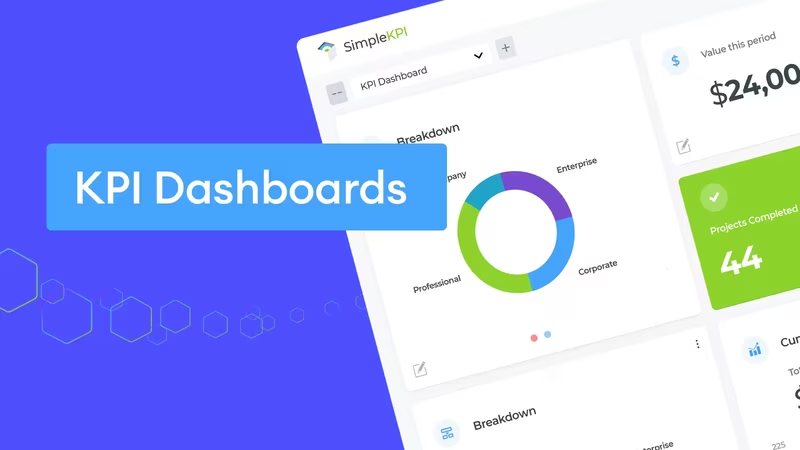What is a KPI Dashboard?
A KPI Dashboard uses charts and graphs to display Key Performance Indicators in a logical and straightforward format. This enables the analysis of large datasets to track a company's progress toward its goals more efficiently, while also providing users with a simple and effective tool to make data-driven decisions that improve a company's overall performance.
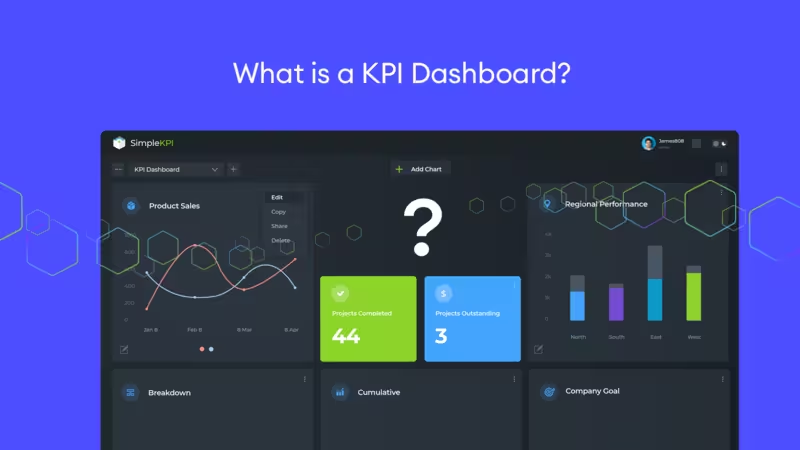
When implementing a KPI Strategy, a KPI Dashboard becomes an essential part of monitoring the performance of individuals, teams, and departments against their targets and goals. This leads to a transparent and manageable way in which to identify trends, opportunities, and threats to the overall strategy.
Also in this guide:
- What are the benefits of tracking KPIs on a Dashboard?
- The difference between a KPI Dashboard and a KPI Report
- Creating your first KPI Dashboard
- Choosing KPI Dashboard Software
- Different Dashboard Types
- KPI Dashboard Examples
- Finally, some practical Dashboard tips
- FAQ
- More References and Resources...
What are the benefits of tracking KPIs on a Dashboard?
Understanding where an organization stands, where it has been, and where it aims to go is crucial for its health. Monitoring perfromance offers a structured approach to monitor progress and set future goals.
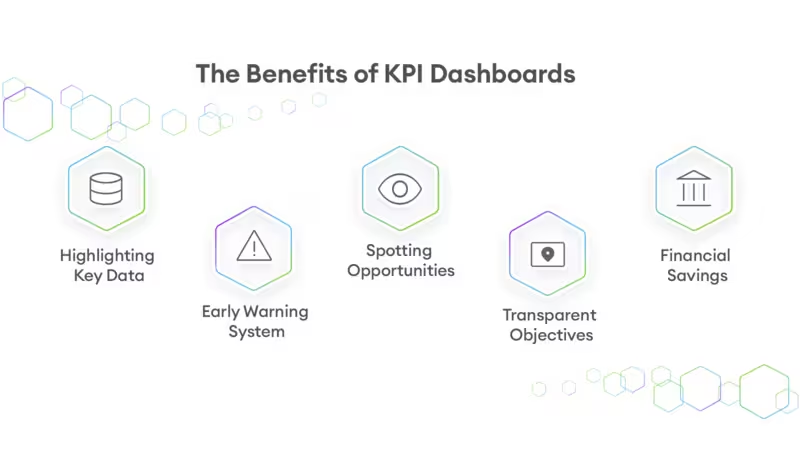
Research shows that companies implementing a performance strategy with KPIs experience significant benefits in growth, market share, and staff retention. A study by the KPI Institute found that 68% of respondents reported a positive improvement in business performance. Tracking KPIs on a Dashboard is integral to this process and provides numerous advantages across the company, such as:
- Highlighting Key Data: Enables managers and individuals to make informed decisions by focusing on the most relevant data.
- Early Warning System: Identifies potential problems early, with analytical tools to diagnose causes and take corrective action swiftly.
- Spotting Opportunities: Uncovers potential business opportunities, allowing companies to capitalize on them faster than competitors.
- Transparent Objectives: Creates a clear framework for everyone to understand and work towards the company's goals.
- Financial Savings: Monitors cost metrics against projects, aiding in accurate future cost estimations and financial savings.
Read More on the benefits of tracking KPIs.
What is the difference between a KPI Dashboard and a KPI Report?
KPI Dashboards and KPI Reports serve distinct yet complementary roles in performance management. KPI Dashboards are interactive tools that provide a real-time, visual snapshot of key performance indicators, allowing users to monitor metrics at a glance.
KPI Dashboards are characterized by their ability to display live data, update automatically, and offer interactivity, such as drilling down into specific data points and filtering information. Dashboards are visually focused, using charts, graphs, and gauges to make complex data easy to understand quickly. They are ideal for real-time monitoring, supporting day-to-day decision-making, and facilitating team collaboration with up-to-date visual data.
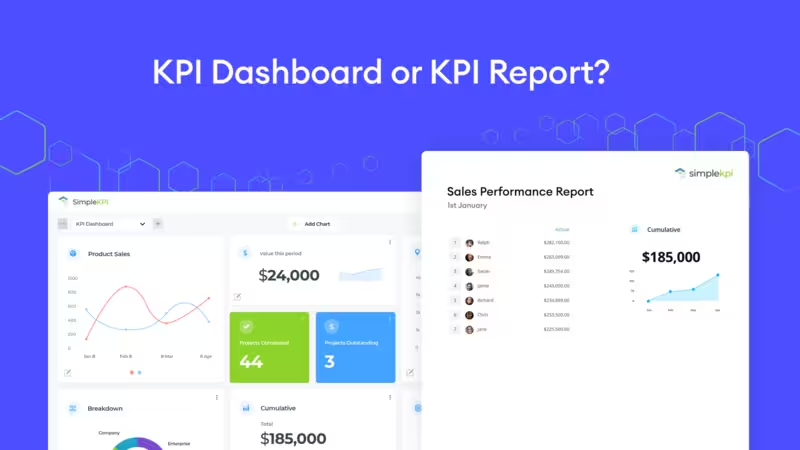
In contrast, KPI Reports are detailed documents that compile and analyze performance data over specific periods, offering a comprehensive review of past performance in a more static format. These reports focus on historical data, providing in-depth analysis, narrative explanations, and recommendations. They are usually presented as static documents, such as PDFs or printed materials, and include extensive data, charts, tables, and text for thorough performance reviews.
KPI Reports are used for periodic performance assessments, strategic planning, and detailed stakeholder reporting, providing valuable insights and context for long-term decision-making. By understanding the distinction between these tools, organizations can effectively leverage both to ensure comprehensive performance management and informed decision-making.
Creating your first KPI Dashboard
A KPI Dashboard should present all your KPIs and Metrics for a specific objective in a concise and visually informative manner.
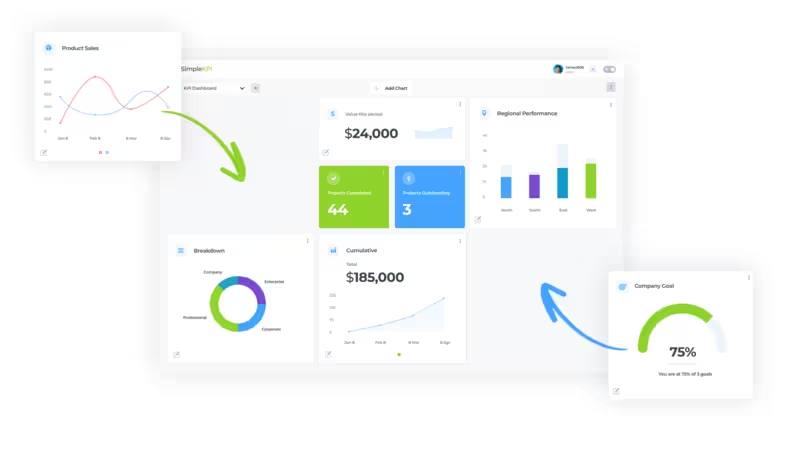
When adding KPI graphs to a dashboard, it’s easy to get carried away. With so much data available from an ever-expanding array of sources, how do you avoid creating counterproductive dashboards and overwhelming your audience with information overload?
Well, here’s 5 simple steps to get you going:
- Choose the KPIs and Metrics to Track:
Identify the most critical KPIs and metrics that align with your business objectives. These should directly reflect the performance indicators vital to your project, department, or overall company goals. A great resource to see what similar companies are tracking is this KPI Generator tool. - Select Your Data Sources:
Determine where your data will come from. This could include internal databases, CRM systems, spreadsheets, or external data sources. Ensure these sources are reliable and updated regularly to maintain data accuracy. - Understand the Intended Audience:
Know who will be using the dashboard. Whether it's executives, department managers, or team members, understanding their needs and preferences will help tailor the dashboard to provide the most relevant and actionable insights. For more insights on how to implement a KPI culture, click here. - Build Your Dashboard with Meaningful and Straightforward Graphs:
Design your dashboard using clear, concise, and easy-to-understand graphs and charts. Avoid clutter and focus on visualizations that best represent your data, making it easier for users to interpret and act upon the information. - Share the Dashboard:
Once your dashboard is complete, share it with the intended audience. Ensure it's easily accessible, whether through email, a shared link, or integrated into your existing tools. Provide training or guidance if necessary to help users get the most out of the dashboard.
Creating a KPI Dashboard: Step by step video guide
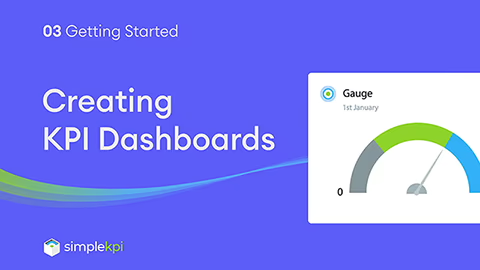
Choosing KPI Dashboard Software
Selecting the right KPI dashboard software is essential for obtaining accurate and actionable insights. Specialized KPI software can streamline this process, offering features and functionalities that general tools might lack.
When choosing the right software, focus on three main questions:
What Do You Need to Track?
KPI dashboards come in various forms, from simple free versions to those following strict methodologies like the Balanced Scorecard, or as part of comprehensive Business Intelligence (BI) solutions.
Understanding your tracking needs and software usage is vital. For instance, if you're tracking a few high-level KPIs, a basic dashboard may be sufficient. However, if you require numerous data integrations feeding thousands of metrics for hundreds of users, an advanced BI solution with a dashboard might be more appropriate.
What Features Does Your Business Require?
Comparing features can be challenging. Most tools offer basic features such as integrations, full-screen modes, and various graphs. However, additional analytics tools, KPI reports, and options for manual data entry can be beneficial as your performance tracking needs expand.
What’s the budget?
Most KPI dashboard software is delivered online with annual and monthly subscription plans. While this model offers cost savings on hosting, hassle-free maintenance, and automatic feature updates, the expenses can add up.
Some providers offer all-inclusive pricing, while others may charge extra for additional users, data storage, and the number of KPIs and dashboards.
Researching feature matrices and cost structures can significantly impact your annual performance budget.
Here are some notable providers of KPI Dashboard Software:
For a more comprehensive look at KPI Software providers, check out this 14 KPI Software guide and review for 2024
Different Dashboard Types
KPI dashboards cover three main aspects of business performance tracking, each serving a specific purpose: strategic, operational, and analytical.
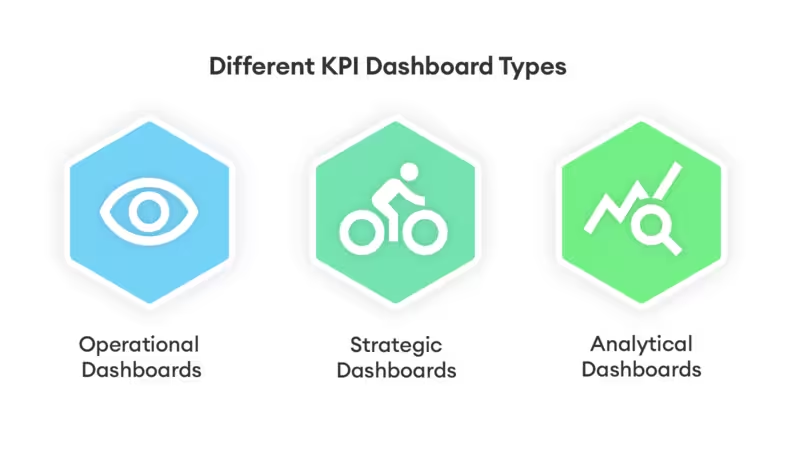
- Strategic dashboards are predominantly used to view the business in its entirety. They contain high-level financial and process-based KPIs. These dashboards are a great way to see the company’s current state and growth. Strategic decisions are made using these dashboards, highlighting opportunities and weaknesses to key individuals.
- Operational Dashboards deliver real-time data to managers and employees, crucial for making informed decisions on daily operations. These dashboards consolidate large amounts of information into easily understandable visuals, making them essential in industries like construction and manufacturing, and departments like sales and marketing.
- Analytical Dashboards allow for in-depth investigation of data anomalies, often referred to as KPI reports. They help determine the root causes of fluctuations and compare performance trends using historical data, offering a comprehensive analysis tool for further insights.
More indepth information on the different dashboard types and how to use them can be found here
KPI Dashboard Examples
Different industries and departments utilize dashboards in very specific ways. From fast-paced sales environments to the production-orientated manufacturing industry. Here is a selection of focused dashboards that are used to highlight performance across a range of businesses.
For a comprehensive look at how different types of KPI dashboards can transform your business performance tracking, visit our KPI Dashboard Examples page. This resource showcases a variety of dashboard styles and functionalities, offering insights into how strategic, operational, and analytical dashboards can be effectively utilized to meet your organization's unique needs. Explore these examples to see how you can visualize key performance indicators and make more informed decisions.
Sales Dashboard
Sales leaders need to monitor sales executives and revenue data to hit targets. In the fast-paced world of sales, performance is closely tracked. An effective sales dashboard provides ’at a glance’ sales information to efficiently manage a sales team.
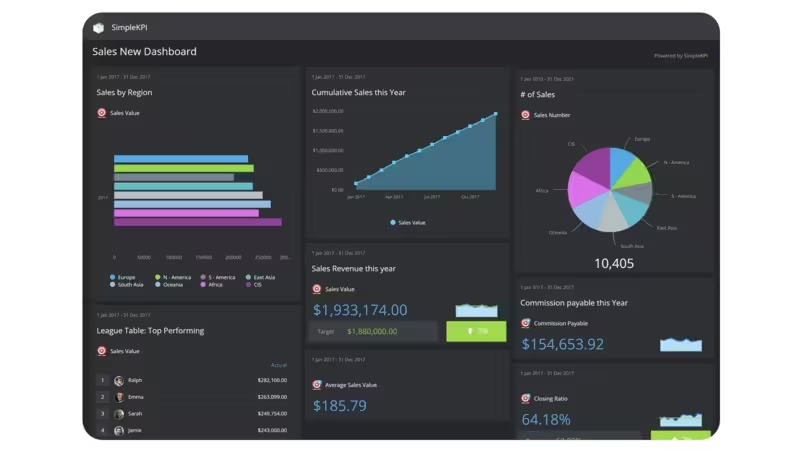
See a Sales Dashboard Example.
Marketing Dashboard
One of the most significant growth areas in dashboard adoption has been in marketing. The sheer volume of data increasingly generated from digital channels lends itself to being visualized via dashboards. Due to this rapid expansion, marketing dashboards now cover many subcategories such as SEO (Search Engine Optimization), Web Analytics, Content Marketing, Social Media, and funnel/pipeline dashboards.
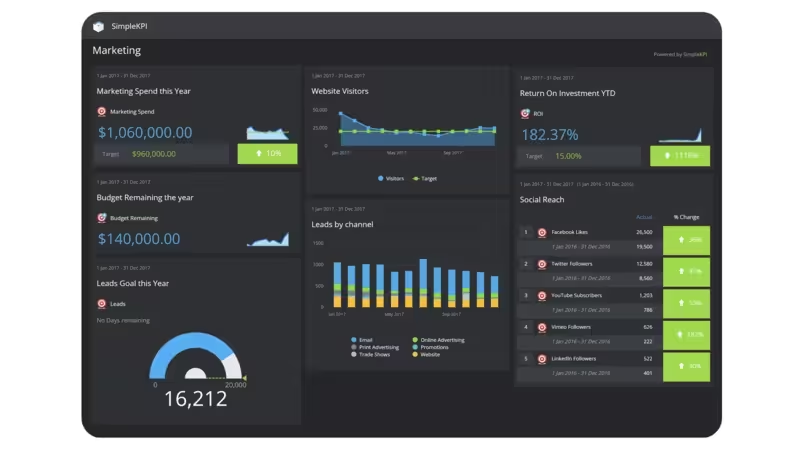
See a Marketing Dashboard Example
Manufacturing Dashboard
Efficiency drives manufacturing. Keeping processes and equipment performing at their optimum can differentiate between success and failure.
Typically manufacturing dashboards are used for both real-time monitoring of performance and analyzing trends. Both help to pinpoint opportunities to improve processes.
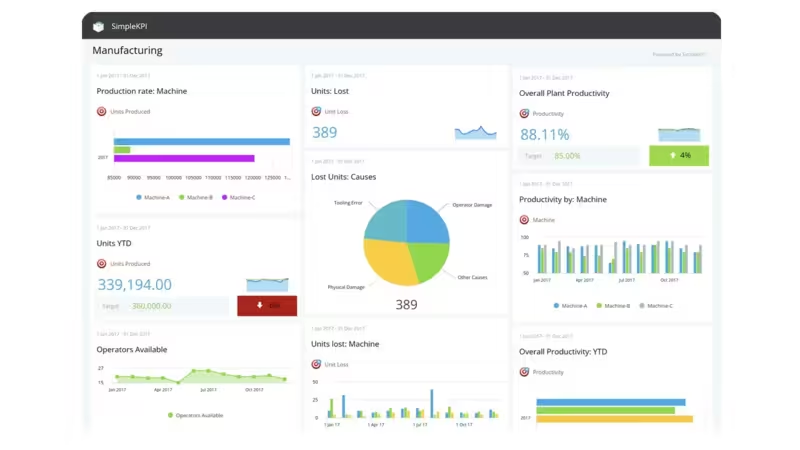
See a Manufacturing Dashboard example
SAAS Dashboard
SaaS (software as a service) companies operate in a fiercely competitive global market, using an unconventional business model. The entire lifetime of a customer, from the initial web search to the acquisition, support, and customer churn is tracked meticulously. SaaS dashboards are an indispensable tool in visualizing all this data so that informed decisions on marketing, product development, support, and investment can be made.
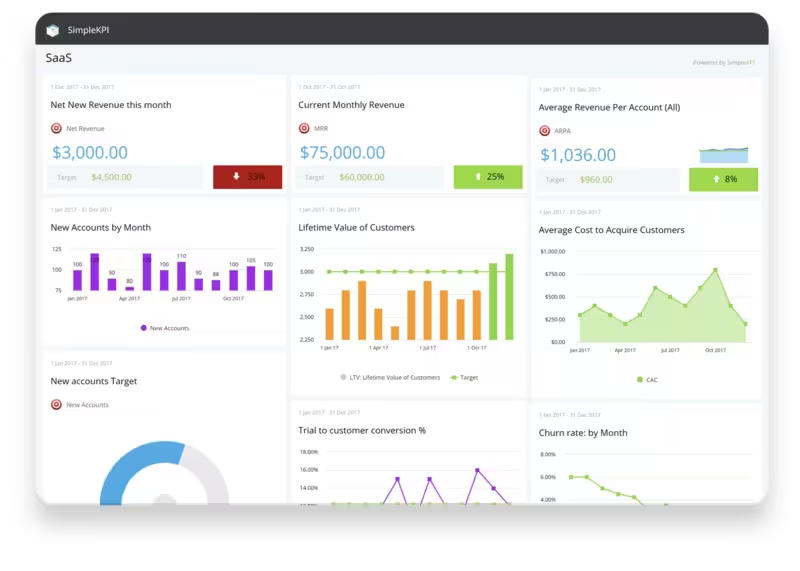
Security Firm Dashboards
To remain competitive, Security firms benefit from using KPIs Dashboards across vital areas of their operations. Worker safety, incident management, and compliance are amongst the most influential areas of performance tracking.
These dashboards provide real-time information to managers, supervisors, and security personnel. They can then make an informed decision on staffing levels, health and safety, and infrastructure.
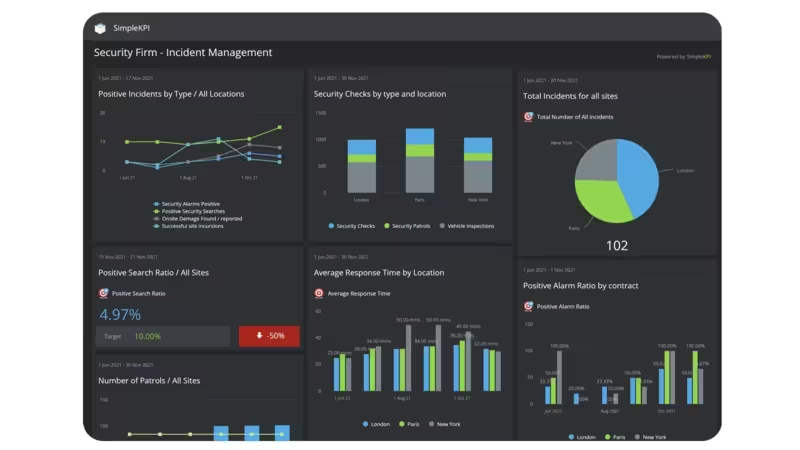
See three Security Firm Dashboard Examples
Finally, some practical Dashboard tips
Here are some tips and best practices that will help you make the most of your dashboards:
KPIs need owners
When KPIs have owners, you get good performance. Without owners, it’s unclear who should interpret the data, communicate the results and initiate any actions that are needed.
Divide your dashboards by function
Group your KPIs and create individual dashboards focused on a specific audience. Strategic Dashboards visualize growth and the organization’s goals. Operational Dashboards for day-to-day operations such as those for Sales teams. Analytics dashboards for investigation and trend analysis. Avoid trying to create a single dashboard to cater to all these functions. Splitting them out will provide the audience with a single purpose to focus on.
Keep it simple
Less is more when it comes to Dashboard design. Aim for a single screen with no more than nine views. Limit the number of colors and use consistently sized graphs. With each graph, ask yourself, is it necessary to show all the historical data if the audience only needs Real-time data?
Use Vanity Metrics Sparingly
Actionable KPIs, such as the number of users completing a particular stage of a signup process, provide information for you to make decisions that can improve performance. Vanity metrics, on the other hand, like the number of website visitors, are helpful but are prone to fluctuations, manipulation and don’t tell the real story. Are these visitors genuinely interested in purchasing your product or service?
Avoid gimmicky widgets
With so many dashboard providers competing for a unique selling proposition, new and unique widgets appear almost daily. For example, the ‘latest time in London,’ an image rotator, or a ‘latest tweet’ provide little to no real actionable information – they just add to the clutter.
Timely Reviews and adjustments win
As with any business tool, regular reviews and maintenance are needed to keep them performing at their best. Having KPI owners contribute to regular ‘optimization’ reviews will reduce information overload and further improve performance.
Set your dashboards free
There is no point in creating beautiful dashboards when they are limited to a single person or hidden behind numerous logins. The information contained needs to be communicated to all shareholders involved in the process. Consider sharing dashboards freely, both internally and externally, and provide a feedback mechanism.
Combine metrics to create actionable KPIs
Consolidating metrics into a single actionable KPI will provide direction for practical actions. For example, dividing the number of signups to a service by the number who completed a specific stage will give you the information to help change areas of the process that are under-performing.
Clean and accurate data
Rubbish in rubbish out. If data is inaccurate, then it does not matter how beautifully designed your dashboard is; it just won’t have the right fuel to perform. As much as is reasonably possible, try to test data for reliability and accuracy.
Measuring something is better than measuring nothing at all
Implementing an organization-wide set of Dashboards can be a daunting prospect. Start small; even a single graph might provide a welcome insight - and let’s face it, without any measuring, would remain undiscovered.
The optimal number of KPIs on a dashboard typically ranges between 5 to 10, ensuring a balance between comprehensiveness and clarity. This range allows for effective monitoring of critical metrics without overwhelming users with too much information, making it easier to focus on the most important performance indicators that align with strategic goals.
A KPI dashboard is a visual tool that displays key performance indicators (KPIs) to provide a quick overview of an organization's performance, typically focusing on real-time data and short-term metrics. In contrast, a balanced scorecard is a strategic management framework that not only includes KPIs but also aligns them with the organization's long-term objectives across four perspectives: financial, customer, internal processes, and learning and growth.
KPI dashboards, while powerful, have several disadvantages including the potential for information overload if not properly managed, the risk of focusing too much on easily measurable metrics rather than strategic goals, and the dependency on accurate data input, which can skew insights if the data is flawed. Additionally, setting up and maintaining these dashboards can be resource-intensive, requiring significant time and expertise to ensure they align with business objectives and provide relevant, actionable insights.
More References and Resources...
Explaining Key Performance Indicators
For a deeper understanding of Key Performance Indicators (KPIs) and their significance in tracking business success, visit this detailed explanation on Explaining Key Performance Indicators. This resource provides valuable insights into what KPIs are, why they matter, and how they can be effectively implemented in your organization.
KPI Institute
For expert insights and resources on Key Performance Indicators, visit the KPI Institute. This renowned organization offers comprehensive guidance on KPI development, implementation, and best practices to help you enhance your performance measurement strategies.
Stacey Barr
For professional expertise on performance measurement and tracking Key Performance Indicators on Dashboards, visit Stacey Barr. Stacey Barr provides valuable resources and insights to help organizations develop effective KPIs and improve their performance management practices.
Also see...
What are Key Performance Indicators?
/Resources/Key-Performance-Indicators
KPI Library with over 200 KPIs and Templates to use
From the blog...
What are Metrics and Measures
/Blog/metrics-and-measures-a-definitive-guide
5 Examples of KPI bad practice
/Blog/5-Examples-of-KPI-bad-practise

by Stuart Kinsey
Stuart Kinsey writes on Key Performance Indicators, Dashboards, Marketing, and Business Strategy. He is a co-founder of SimpleKPI and has worked in creative and analytical services for over 25 years. He believes embracing KPIs and visualizing performance is essential for any organization to thrive and grow.
